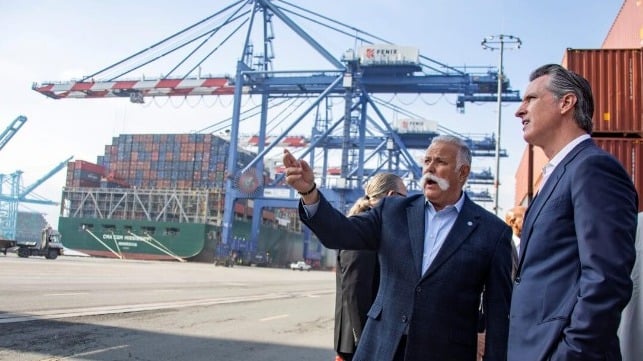Calls for a “Supply Chain Emergency” While California Cites Progress

California is continuing its efforts working to elevate some of the issues that may be contributing to the backlog at ports across the state. Touring the Port of Long Beach on Wednesday, Governor Gavin Newsome touted the successes while announcing more efforts aimed at the trucking industry, while elected representatives from the state are urging the governor to declare a “supply chain emergency” and wave state restrictions which they said are slowing the movement of cargo.
“Major changes in consumer habits driven by a global pandemic have led to all-time record high volumes of containers moving through Los Angeles and Long Beach ports. Thanks to the collective work of California and our partners, we have seen a 32 percent drop in containers sitting on the docks,” said Governor Newsom during his visit to the ports. “California has taken swift action across the board to address congestion and increase our capacity to move goods quickly. I am grateful for the cooperation of both the public and private sectors – from the federal government to the ports, the workforce, the retailers, and the shipping lines – for the additional commitments they’ve made to tackle the backlog.”
Governor Newsom announced that Caltrans will begin issuing temporary permits allowing trucks to carry heavier loads of up to 88,000 pounds on state highway and interstate routes between the Ports of Los Angeles, Long Beach, and other statewide ports and distribution centers. Further, the Department of Motor Vehicles is nearly doubling its capacity to conduct commercial driving tests to address the national shortage of truck drivers for the big rigs.
In Washington, D.C. today, eight Republican U.S. Representatives from California responded saying that more still needs to be done. They called on the governor to immediately waive some of California’s restrictive emissions standards which they say are preventing trucks from servicing the ports. They cited eight California laws, including a restriction on the use of independent truckers, which they contended would further improve the situation if they were rolled back or waived.
John Porcari, the port envoy to the Biden-?Harris Administration Supply Chain Disruptions Task Force joined the port tour on November 17 noting to reporters, “Many of the biggest challenges our ports are facing today have been years in the making. I am grateful for California’s partnership and dedicated focus to produce outcomes that will reduce congestion, improve operations, and set us on a sustainable path for the future.”
Port Envoy Porcari has been leading thrice-weekly meetings with terminal operators, shipping lines, and other key stakeholders to identify operational problems and immediate solutions at the two ports. In addition to the 32 percent drop in long dwell time containers at the ports, they said the carriers over the weekend had removed 10,000 containers from the estimated 72,000 boxes crowding the terminal yards. The Port of Los Angeles highlighted that additional “sweeper vessels” were expected to further remove the empties from the yards.
Experts have predicted that it would take time to reduce the backlog confirmed by the numbers of vessels at the two ports. After setting new records at the beginning of the week for the total number of vessels and the number of vessels waiting offshore, the number ticked down slightly. However, it continues to swing back and forth with the latest report showing a higher-than-normal number of vessels due in the next few days. New regulations will relocate the waiting vessels further offshore, but it continues at over 100 vessels awaiting terminal space, with the designated anchorages full and the terminals occupied with around 60 vessels on any given day.
